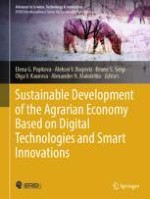2024 | Buch
Sustainable Development of the Agrarian Economy Based on Digital Technologies and Smart Innovations
herausgegeben von: Elena G. Popkova, Aleksei V. Bogoviz, Bruno S. Sergi, Olga V. Kaurova, Alexander N. Maloletko
Verlag: Springer Nature Switzerland
Buchreihe : Advances in Science, Technology & Innovation
